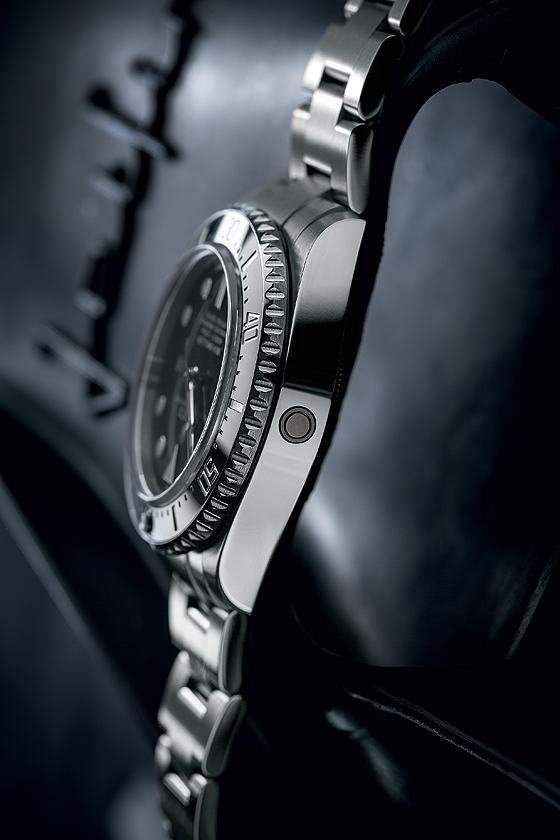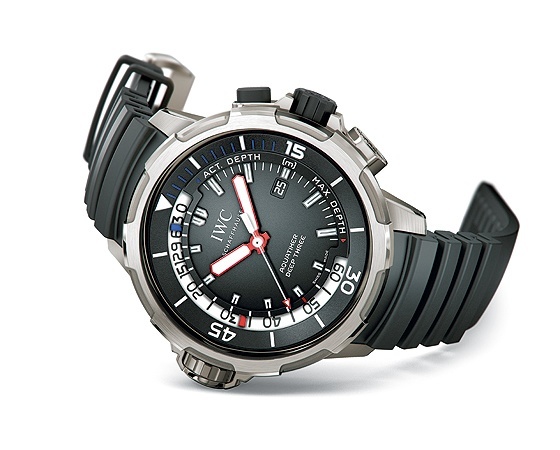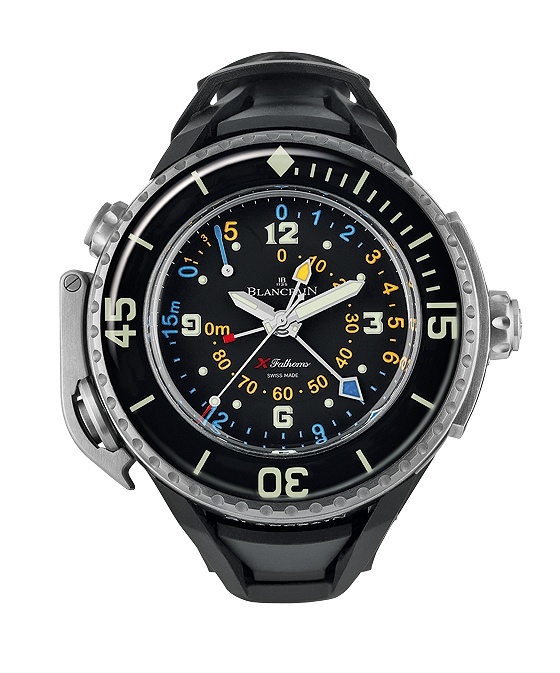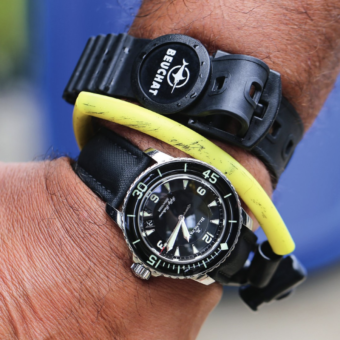We answer your FAQs about water resistance, dive bezels, depth gauges, and more about divers’ watches in this feature from the WatchTime archives.

How water resistant should a dive watch be?
Some manufacturers say that their watches with a water-resistance rating of 300 meters or more are suitable for recreational scuba diving. Others say the watch need have a rating of just 200 meters; still others say it can be 200 meters as long as it is specifically labeled as a dive watch. The International Standards Organization (ISO), on the other hand, stipulates that a dive watch must be water resistant to 100 meters.
All these depth ratings are significantly higher (or lower, if you will) than the depths to which a non-professional diver can dive. Recreational divers don’t go deeper than 40 meters (130 feet). Beyond that, they enter the realm of technical diving, which requires extensive training, special mixed gases to breathe, long decompression stops and special equipment.
The reason for the discrepancy: when tested for water resistance in the factory, the watch is in an artificial environment that is much different from what the watch will face during an actual dive. For the test, the watch is perfectly stationary, the gaskets brand new, and the case newly assembled, so that nothing will compromise its water resistance. The testing machinery does not account for such phenomena as additional pressure from the impact of the wearer’s jumping or diving into the water; or for temperature and pressure changes as the diver ascends and descends, which can cause the case to shrink or expand. Furthermore, a watch’s water resistance will be lessened by aging of the watch’s gaskets. Knocks and other rough treatment can cause the case’s components to fit together less tightly than they did when the watch was brand new. All these imponderables cause the companies to provide a rather large cushion of safety so that customers will not hold them responsible if their watches leak.

What features make a watch impermeable enough for diving?
Several features are required to make a watch impermeable enough to wear diving. In nearly all dive watches, the case has a screw-in back and crown. O-rings are used to seal the crown, caseback and crystal. The case and crystal are thicker than in a non-dive watch. Watches designed for very deep diving often have additional pressure-defying features such as domed crystals, or a steel ring for reinforcing the case (as on the Rolex Deepsea).
What are the other features of a dive watch?
Most dive watches have a rotating bezel for measuring elapsed time. They also have luminous hands and markers that can be read underwater. ISO standard 6425 requires a dive watch to have a “time-preselecting device” (a rotating bezel satisfies this requirement) and a dial that can be read in the dark at a distance of 25 cm. The ISO also says the watch must have an indicator that shows at a glance if the watch is still running. A seconds hand satisfies this requirement. Most dive watches have a steel or titanium bracelet or rubber strap, although some straps are made of nylon or various composite materials. Some dive bracelets and straps are equipped with an extension device that enables the watch to fit over a dive-suit sleeve. Some dive watches have a helium valve and/or a depth sensor.

What is a helium valve?
A device for equalizing the pressure inside and outside the watch case when the watch is worn in a diving chamber. Inside the chamber, divers breathe a gas mixture that contains helium. The helium molecules are extremely small and are hence able to penetrate the watch case, building up inside it. In the process of decompression, the pressure inside the chamber decreases more rapidly than the pressure inside the case. This can cause the watch crystal to pop off. To prevent that, some watches have a valve on the side of the case that allows helium to escape from the case during decompression, making the pressure inside and outside the case the same.
Do many dive watches have helium valves?
Most dive watches do not have helium valves because they are of use only in saturation diving, when a diver spends time in a diving chamber.

Why do the rotating bezels on most dive watches turn in only one direction?
Most dive bezels turn in one direction only, counterclockwise, so that the bezel cannot be accidentally knocked off position in the clockwise direction and thus understate the elapsed time (usually the total dive time) being measured. Some watches solve this problem by using inner rotating bezels that cannot be rotated accidentally.
Many bezels have only the first 15 minutes marked individually. Why?
This is a dive-watch convention that goes back to the mid-1950s (it probably started with the Rolex Submariner). It is unclear what purpose the markers were originally meant to serve. An early Submariner advertisement shows a diver setting the bezel to measure total dive time, then using the minutes markers for a precise reading of his descent time. Why this information is useful is not explained (and standard diving procedures don’t require it).
An oft-tendered explanation for the markers is that they are used to time decompression stops, but this explanation is problematic. The diver would have to reset the bezel at the beginning of each stop. The bezel could not therefore be used to measure total dive time, the main purpose of the bezel.
One possible explanation for the markers: 15 minutes is the approximate amount of time a diver can spend at 130 feet, the maximum depth for recreational diving, without making decompression stops. The markers might have been intended to alert him to that limit and help him read his remaining bottom time precisely. This theory is supported by some versions of the Omega Seamaster, which had gradations for the first 20 minutes (a diver can spend about 20 minutes at 110 feet, close to the depth limit). On the Seamaster 200, the 20-minute segment was painted fire-engine red, possibly to warn the diver of the hazard of staying deep for too long.

How do depth-gauge watches work?
In most, there is a sensor (typically a membrane or diaphragm) on the side of the case that is distorted by water pressure. The degree of distortion is then converted into feet or meters of depth and displayed by hands on the watch face. Oris, in its Aquis model, uses another type of depth gauge: it has a tubule around the perimeter of the crystal with a tiny opening to the outside. More or less water enters the tubule, depending on the depth, and the diver can read the depth in meters on the scale next to the tubule.
How many mechanical dive watches have depth gauges?
Just a handful. Aside from the aforementioned Oris Aquis Depth Gauge, other mechanical watches with depth gauges include the Blancpain X Fathoms, the IWC Aquatimer Deep Three, the Jaeger-LeCoultre Master Compressor Diving Pro Geographic and the Panerai Luminor 1950 Pangaea Depth Gauge (which despite its mechanical movement has an electronic depth gauge).
Some watch depth gauges record the deepest point of a dive. Why?
There are three reasons. First, for safety’s sake, the dive-time limits prescribed by dive tables assume the diver spends his entire dive time at the deepest point of the dive. To use the dive table, the diver must therefore know his deepest point. Second, it is a generally accepted rule of diving that the diver should do the deepest part of the dive first. This gives him the maximum amount of time to off-gas the relatively high amount of nitrogen he absorbed at the bottom of the dive (the lower you go, the more nitrogen dissolves in your blood). Third, many diving experts recommend that, even in no-decompression diving, which doesn’t require decompression stops, the diver make a so-called “safety” stop of one minute halfway between the lowest point of the dive and the surface in order to off-gas nitrogen.


Which mechanical watch has the deepest water-resistance rating?
The CX Swiss Military 20,000 feet. The watch, made of titanium, is nearly 3 cm thick; the crystal alone is 1 cm thick.
In this age of dive computers, are dive watches necessary?
Not really. Divers sometimes take them as backups to their dive computers, should the computers run out of power during a dive, but now that wrist-worn dive computers are widely available and reasonably priced, some divers use these as backups to their console-style computers (or wear two wristwatch-style computers). If a diver does use a watch as a backup, he also needs other backup equipment that supplies information given by a dive computer: a depth gauge, pressure gauge and dive tables.
Then why do so many people buy dive watches?
For several reasons. Many people like the sense of security that a high water-resistance rating provides. If a watch is safe to wear on a deep dive, they reason, surely it is guaranteed to survive a swim or a snorkeling excursion. Others like a dive watch’s other features, such as a rotating bezel or highly luminous hands and markers. For many dive-watch wearers, looks are the main draw: sporty, technical-looking watches are all the rage.








Decompression dives are intended to be planned so that the divers knows how long he can stay at the maximum dive depth. Dive duration is measured from the time one leaves the surface to the start of the actual ascent. Once the diver sees from the bezel elapsed time indication that he has reached his time limit he begins the ascent. The bezel can now be reset to measure the stage steps where the minutes required can be counted off. A marked drop line depending from the surface often indicated the depth of the stage stops. Decompression tables factor in the ascend time between stages, the diver rising no faster than a given rate, usually his slowest exhalation bubbles. Divers used to carry plastic card dive tables and underwater slates although in a planned dive these times had already been decided, but there can be variations if the dive has not gone to plan.
Do you make women’s watches
Thankyou for your indepth analyse of what trully makes a dive watch .The practically. aesthetics.and robustness for me culminates to be the perfect watch for me by far
Thankyou for your indepth analyse of what trully makes a dive watch .The practically. aesthetics.and robustness for me culminates to be the perfect everyday watch
the Blancpain is the must beautiful.
I am a saturation diver. In dive school we were taught that the last 15 minutes is to time your ascent from the last deco stop in recreational diving. From 10 feet it should take about 15 seconds. Anymore people do it in 10 seconds, but it’s still not a horrible idea.
Great design
With a mechanical automatic dive watch, how often do you set the time? Does setting the time more often (twice a week, as example) significantly reduce the waterproof rating over time?
How or where can I purchase a dive watch and how much are they please.
During underwater work your watch is at times exposed to collisions with hard and sometimes sharp objects, hence it needs to not offer any catching edges that can snag and instead slide off. This is why Seiko’s Tuna (600 and 1000 with their armoured shrouds) is a good dive watch in its titanium versions with a ceramic coating on the shroud.
What is the cheapest and affordable divers watch.Thanks.
What are the precision tolerances for an OMEGA chronometer? 00004000 What are the precision tolerances for an OMEGA chronometer?
The short version: Omega’s Master Chronometer certificate requires an extraordinarily high level of magnetic resistance of 15,000 Gauss plus an accuracy rate of less than 0/+5 seconds per day. COSC is -4 sec to +6 sec., or up to 10 seconds per day. The long version can be found here: https://www.omegawatches.com/planet-omega/watchmaking/the-master-chronometer-certification/
I love divers watches , they are built to handle extreme conditions that you would not normally find yourself in , 300 metres under water. They big luminous hands and numbers and a very useful bezel to time all sorts of things.
More importantly when I go to the beach for a swim my watch goes with me in the water where thieves who still your belongings left on the sand unattended cannot touch your much loved divers watch.
You see dear friends many years ago I was a victim at Bondi Beach in Sydney, I had to leave my non divers watch behind securely tucked away in my clothes and towel but alas some low life stole everything including my clothes , watch and towel.
Not anymore my watch goes with me in the water, peace of mind. Divers watches rock, baby they rock!
Question: Many bezels have only the first 15 minutes marked individually. Why? In the mid-fifties the average decompression time at individual stations was less than 15 minutes. Decompression time is consider a practice that has to be accurate. Divers were able to quickly set the bezel 0 against the minute hand and then watch it tick off minutes more easily than trying to read the watch face going from one random time to the next. In the early days of SUBA decompression dives were not as long as today. Likewise, deep dives were planned with high degrees of accuracy so the divers knew how much bottom time limit they had. The minute markings on the bezel allowed divers to easily determine down time and remaining time at a specific preplanned depth; in the early days this was typical less than 15 minutes.
I disagree in the necessity of having a dive watch on, as many free divers would argue, we don’t always require a dive computer, your watch on a vacation would serve the purposes for recreational freediving or diving. As long as a depth gauge is there,”dive” watches without a depth gauge are not dive watches in my opinion and they shouldn’t be advertised as such, what? I would stare at the time down below? No I need a functionality, that is related to the sport I’m doing, hence the inclusion of a depth gauge. I would argue though that this has been recently used as a PR stunt to hype up prices of luxury dive watches, since Japanese brands like Seiko have stopped providing depth gauges to their dive watches.
right on the point.cant agree more
…good read ….. personally I enjoy my dive watch for the looks …but more than that we do a fair amount of water sport activities…knee boarding , barefooting etc …I’ve a Seiko dive watch …300 meters …several hundred bucks ….there’s better watches , I’m sure ….but this one suits me fine …..thx for the article …cheers
Good watch
I want to purchase
While I totally understand the necessity for dive watches, I just like their look & functionality. I have a small collection watches, majority of them are in the “dive watch style” however I don’t do any diving at all, probably never will. I have 4 with the helium release valve on the side opposite the crown, a few rated to 1k meters. I really just love the look of the watches, some with silicone bands, more with stainless steel bracelets. As the cell phone has taken over as everyone’s modern-day primary source of time telling, I find it more important to continue wearing watches of any variety to keep something so important to our past relevant in our future…
Awesome
Love reading this article
Years ago, I bought a $99.00 watch at Target, a Casio G-Shock 200 meter watch, solar powered, and connects to the atomic clock to keep it accurate. I’ve had it diving everywhere from Cozumel, to Australia, to 180 feet down on a wreck in Truk Lagoon. It works fine as a dive watch and an everyday timepiece
I Bought A Seiko Kinetic Diving Watch In 2008. Excellent Watch!!! Have Never Had The Watch At A Watch Shop.It Still Runs Very Good.Seiko Makes Watches To Last.
I’m not diving but would like a handsome looking diver watch. My price point $250 or under. Looking for something off the beaten path not a Casio Seiko citizen. I travel alot and beach sand surf fishing etc is done so something I can wear everyday. Any suggestions?
Enjoyed the article. So much info. Thanks. My favorite style for 35 years. Diver, auto, screw-down crown.
I have Swiss Army and Stuhrling dive watches. What I need is a watch that I don’t have to remove for a shower, go swimming, or reach into water (for any reason). They’re both good to 200 m. After I replaced the crown on the Swiss Army (scratched bad) and the gaskets it was no longer water proof after being in a pool. It lasted through three batteries without a problem. The Stuhrling is the replacement and so far it’s good.
That was extremely informative
Nice article , however a bit disappointing not to see any mention of DOXA. As you’ll probably not know, it was Rolex who went cap in hand to DOXA requiring help to develop the Auto HE valve. Again in this article 3 Rolex pictures, not any DOXA. DOXA did just as much Dive Watch development with Aqua Lung in US as Omega & Rolex did with Conpex. It would be nice to see the small brands get recognized once and a while.
My favorite watch is the CF Bucherer Patravi ScubaTec…I own 3 variants. My ScubaTecs are my favorite watches because they have a very legible 3-hand dial, a very robust bracelet with 10mm of micro-adjustment, and they’re built like a tank. They’re perfect whether I’m at gym, casual dress, or moderately formal. I can wear the watch in any environment and not worry about hurting it. I have a 7.5″ wrist, so the 44.6mm diameter fits me well.
Interesting article, thanks. I snorkel and swim lots, love the looks of a dive watch, but wear a Rolex GMT Master II… it has all the style of a dive watch, is waterproof to 100m, has a rotating bezel, but has three time zones and a 24hr hand. Far more use to me!
The dynamic pressure claims you make (from movement underwater or jumping in) are false. An analysis of the maximum possible difference from still to the most movement possible adds the equvalent of 9ft more depth. Not an issue.
The claim that only technical dvers can go below 40m and that you need special gas mixes and equipment is false. Standard air takes you to 54m, no special equipment is required at all.
Nitrogen builds up in all tissues, it doesn’t just dissolve in your blood.
Divers wear dive watches to tell the time. Imagine that. Unfortunately most dive computers don’t have the actual time on their primary display. Also, using a bezel to time is easier than counting kick-cycles if you are doing a grid search for something, like trying to locate a wreck in low-visibility. Its a good back-up bottom timer too.
The fashion for bezels to only be indexed to 15 or 20 minutes is frustrating. Like a millimeter ruler with only the first 30mm indexed and just centimeters for the rest! The current ISO dive watch standard requires the bezel be indexed for 60mins but this is frequently ignored.
Otherwise, an interesting article!
What a horrible way to express your thoughts. Smart ass
What’s so damn horrible? The guy was very precise in his analisys. If only more people were like that. So F off snowflake.
Strange you would be upset with the article being corrected rather than it having several errors. A diver being frustrated that watch makers don’t follow the ISO guidelines doesn’t equate to be a smartarse IMO.
I have a nodate Sub that I use as a work watch in the coastal areas of Australia’s Northern Territory. Sea water, sand and mangrove mud are its daily diet but no diving.I wear it because it can handle the harsh conditions and knocks.I have a couple of cheaper divers but always end up buck wearing the Sub. The rotating bezel is used for a multitude of things.
I’m not a diver but I love them for their looks and toughness. I’m not a suit and tie kind of guy either and enjoy participating in sports and the gym. They suit my lifestyle and I’m not interested in smart watches or activity tracker’s. I often use the bezel to mark the time for running and other activities. I love it.
I enjoyed the article on dive watches very much. I believe all aspects whether good or bad were touched on in a realistic manner. Particularly, the section regarding the use of dive computers. I dove professionally during my time in the military as well as recreationally and just about everyone that I dove with wore a dive computer. I will never say that an Omega Seamaster looks out of place on the arm of a wetsuit but for a savings of about $5500 dollars one could have an instrument that will give them all the life saving facts regarding their dive profile, not just the time elapsed. After returning recently from a trip to the Caribbean and having the chance to see and wear numerous high end dive watches, not to mention enduring routine sales pitches from dealers about helium escape valves and the watches ability to go to 2000m. I am convinced few of these people know anything of diving. Thanks again for a great article. Steve Jarvis, Nova Scotia, Canada
Good article. Now you might want to tackle the bogus claims on Orange dials under water. We have done real life tests and Orange is useless. under 15 meters unless you have light.